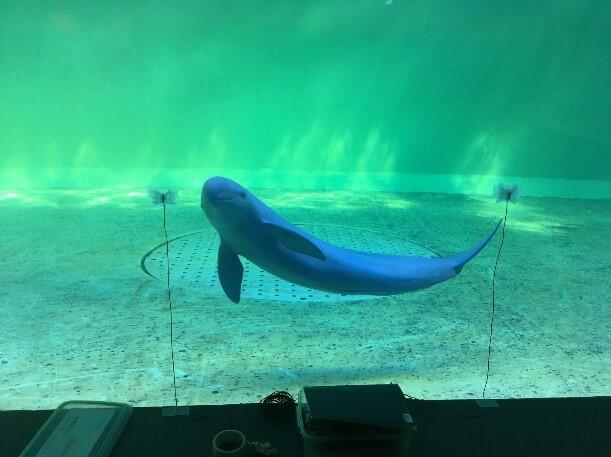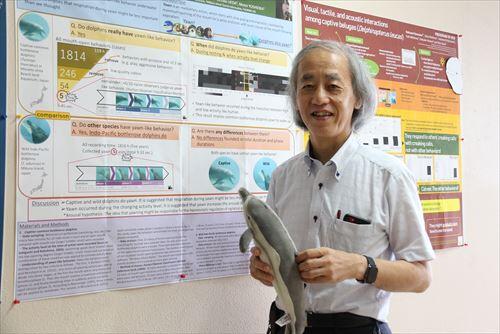Summary of our research
Mr. TERADA Tomoyoshi (a 2nd year Doctoral student of Graduate School of Bioresources, Mie University) found communication sounds in captive narrow-ridged finless porpoises in Toba Aquarium, Mie during a collaborative study under the supervision of Assoc. Prof. MORISAKA Tadamichi and Prof. YOSHIOKA Motoi.
The narrow-ridged finless porpoise is a small toothed whale that inhabits coastal areas from China to Korea and Japan. The species is listed as Endangered (EN) on the Red List of International Union for Conservation of Nature (IUCN). Their habitats in coastal areas are always exposed to human activities, and they still face the risk of extinction; thus, urgent conservation activities are required. To conserve porpoises, basic information of their ecology and proper assessment of the impact of human activities on them are needed. Sounds are effective tools for remote communication in an aquatic environment, and dolphins heavily rely on acoustic communication. For example, common bottlenose dolphins, which live in relatively large groups, frequently produce communication sounds. However, there is no research on the sounds of narrow-ridged finless porpoises for communication except those for echolocation (ability to sense surrounding environment through the detection of echoes of emitted sounds).
We recorded the sounds and behaviors of six narrow-ridged finless porpoises in Toba Aquarium to investigate whether narrow-ridged finless porpoises have communication sounds. We found a unique sound type, which we named "packed sound," at the time when the porpoise was isolated from others. They produced this sound type much less when there were two or more porpoises. However, the "burst pulse" sound, which many other dolphin species produce, was not often produced by the porpoise when they were isolated from others, but was often produced when there were both males and females. In addition, this sound type seemed to relate to affiliative sexual behavior. According to these findings, we suggested that "packet sound" has a function of "contact call," a sound for maintaining relationships, and "burst pulses" have a certain function related to affiliative sexual behavior. These findings imply that anthropogenic noise (such as from ships and/or underwater drilling) has a large negative impact on the sound communication of porpoises.
The study was published online in the scientific journal "Journal of Ethology" on 8th August 2022.
Communication sounds produced by captive narrow-ridged finless porpoises (Neophocaena asiaeorientalis)
https://link.springer.com/article/10.1007/s10164-022-00755-0

Researcher information

TERADA Tomoyoshi
second-year Ph.D. student, Gladuate School of Bioresources
Specialized area:
Bioacoustics, Ethology
Current research field:
Sound communication and awareness of others in narrow-ridged finless porpoises

MORISAKA Tadamichi
Associate Professor, Cetacean Research Center, Graduate School of Bioresources
Specialized area:
Bioacoustics, Ethology, Cetology
Current research field:
Description of interesting behaviors in cetaceans, Development of the elementary techniques for cetacean conservation, Basic study for cetacean communication and society

YOSHIOKA Motoi
Professor, Gladuate School of Bioresources
Specialized area:
Marine mammalogy, Reproductive physiology
Current research field:
Understanding of the mechanism of cetacean reproductive physiology, Understanding of the life history of narrow-ridged finless porpoises in Ise Bay